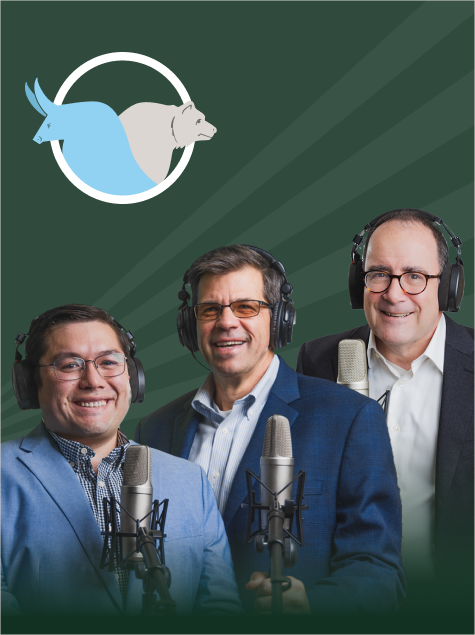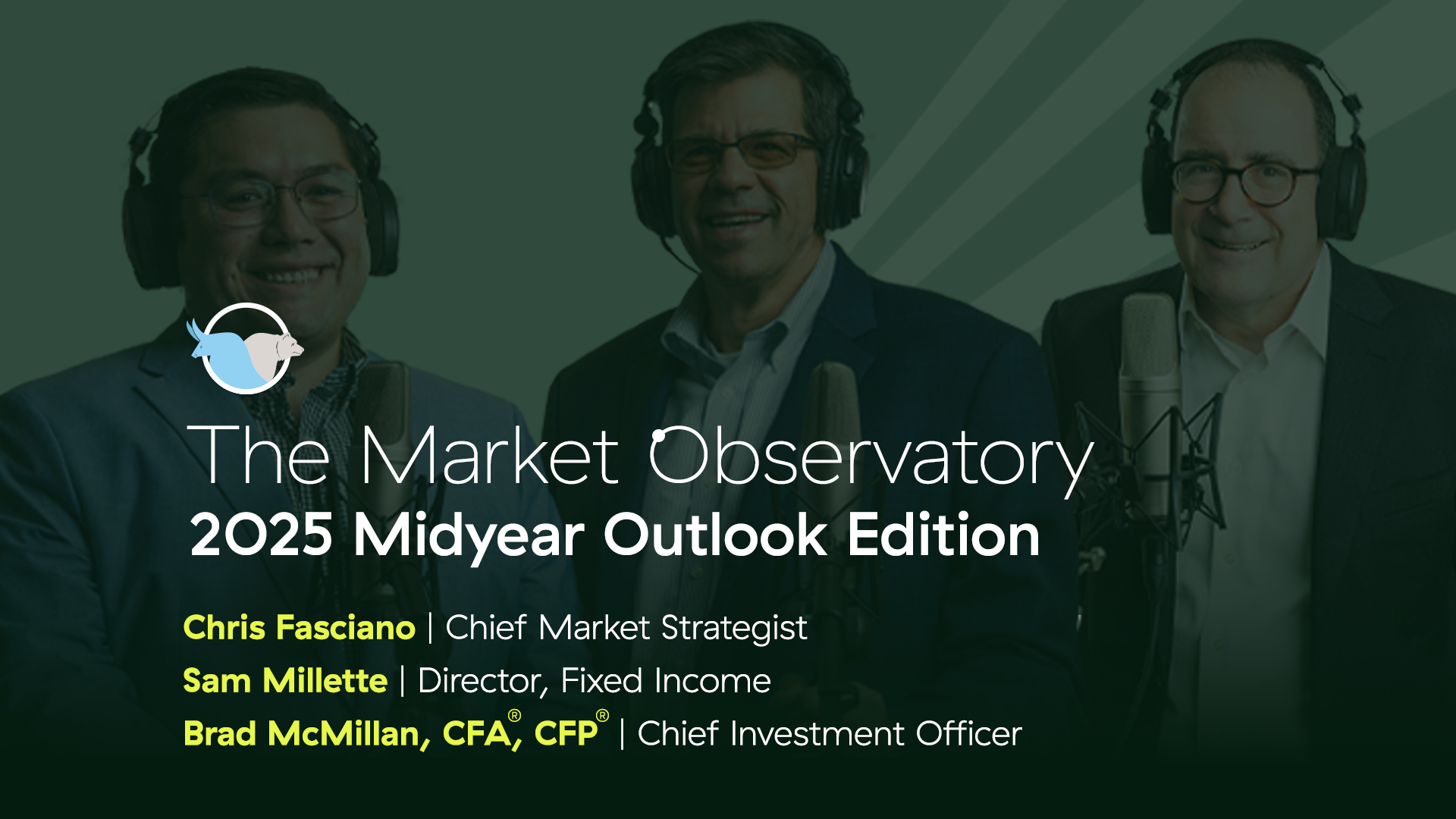2025 Midyear Outlook: The Market Observatory [Video]

As we enter the second half of the year, what can investors expect for the economy and markets? That's the big question we set out to answer in this special Midyear Outlook edition of the Market Observatory. This month, Sam and I are excited to welcome Brad McMillan, chief investment officer, as our special guest.
In this wide-ranging conversation, we take a closer look at the major themes that could impact the road ahead, including tariffs and trade policy, rising inflation expectations, and even potential signs of recession. Watch the video for the full story.

Duration: 05:57
Sam, Chris, and Brad
Welcome to the Market Observatory, where we scan the economic horizon and spotlight the key trends that will shape the month ahead. I'm Sam Millette, director of fixed income research. And I'm Chris Fasciano, chief market strategist. This month, we're excited to bring you a special Midyear Outlook edition of the Market Observatory, joined by very special guest Chief Investment Officer Brad McMillan. Welcome, Brad. Great to be here. Thank you for having me. We're looking forward to hearing your perspective, Brad. So, let's jump right in with what we're expecting for the economy and markets in the second half of the year.
Chris
The first half of the year was quite a roller coaster, driven almost daily by headlines about tariffs and trade policy, and those headlines had a big impact on the equity markets and the fixed income markets. But the other area we saw was in some of the soft economic data, like consumer confidence, which dropped to lows that we haven't seen in a long time. But the interesting thing is that the hard economic data remained pretty robust. Jobs growth has slowed, but we still have pretty good jobs growth. And that means people still have money and they're spending it. So from my perspective, I think what we need to see going forward for that to continue is we need to get some resolution around trade policy that eliminates or reduces tariffs further. And then we need to see the budget bill get negotiated, agreed to, and pass in Congress because that will actually start to put some stimulus into the economy in the back half of the year. And I think if we can continue to build that momentum in the back half of the year, then that will have meant the momentum we saw at the end of 2024 allowed us to get through the headwinds. And then you get stimulus to take us into 2026. But I'm curious what you're seeing, Brad.
Brad
Well, I certainly agree with everything you said. And you know, and going forward, we have the existing momentum, and that's likely to continue. But at the same time, that depends on if we get the tariffs sorted out, if we get the budget passed: if, if, if! I mean, you know, there's a lot of things that have to go right for that to happen. And the fact of the matter is, we are seeing some slowdown, and we are seeing some potential signs of recession. So, I don't think that's by any means nailed down. I acknowledge the possibility, and I think the real issue here is that momentum will cushion any downside. But I'm a little bit more cautious going forward.
Chris
So, Sam, that's kind of a wide range of potential economic outcomes that we might see in the back half of the year. What does it mean for fixed income investors?
Sam
Yeah, that's a great question, Chris, and I think it's the exact question that the Federal Reserve has kind of been dealing with throughout the course of this year. It's that idea of where is the economy and what's the right level for monetary policy. I would argue that, as you mentioned, the soft data has been relatively concerning to start the year. You see confidence fall pretty consistently, and a big driver of that fall in confidence has been increased short-term inflation expectations, which the Fed is keeping a close eye on because rising inflation expectations can create a vicious inflationary cycle. With that being said, the hard data, so actually reported inflation data, has been improving throughout the course of the year, right? On a consumer basis, year-over-year, prices last month had their best result in multiple years. So, I think that that's really going to be the question. That being said, uncertainty historically has helped high-quality fixed income, right? So, I think that that could be a potential tailwind for fixed income investors as we enter into the second half of the year.
Chris
Yeah, so it's interesting how we tie this all together, Brad, because there were points in the first half of the year where people were very worried about the way the equity market was functioning and the way the fixed income market was functioning. And I'm curious what you think of that as we move forward.
Brad
Chris, the real takeaway here was, everything was working. You know, the market was responding to very real economic issues, and it was responding in a way that indicated that it was really working through the consequences. In other words, it was rational, and that's exactly what you want and need to see in a market. You know, things change pretty quickly. You want the market to respond reasonably, and that's what we saw. Going forward, there's a lot of things that can happen, as we talked about, but nonetheless, given everything that's already happened and the rationality of the response, I think that reduces the odds of some kind of dislocation, which is what I'm really worried about. So I'm actually reasonably cheerful about we're going to see the market continue to do something responsible rather than something irresponsible.
Chris
And I think that's something we can all agree on, despite the roller-coaster ride we've all been on for the first half of the year, decisions were being made with a rational basis, and that ought to tee the market up to act pretty well functionally going forward. And from my seat, that's a really good thing, because after a couple years where we saw returns driven by a very narrow part of the market, diversification is back in vogue. You've seen other sectors perform well. You've seen international markets perform well. And, Sam, even when the U.S. equity market was coming under pressure, bonds acted pretty well.
Sam
Absolutely. You know, that was one of the silver linings for investors over the first six months of the year was that bonds were acting like bonds in times of uncertainty. And I have full faith that they'll continue to do so in the second half of the year.
Sam
Well, thank you both for an engaging conversation, and thank you all for joining us. Please join us again next month for another update from the Market Observatory. And for further content from our 2025 Midyear Outlook, please check our Insights blog.
For more market and economic analysis, check out our Insights blog: commonwealth.com/insights
Certain sections of this commentary contain forward-looking statements as of the date published that are based on our reasonable expectations, estimates, projections, and assumptions. Forward-looking statements are not guarantees of future performance and involve certain risks and uncertainties, which are difficult to predict. Opinions are subject to change without notice. Bonds are subject to availability and market conditions; some have call features that may affect income. Bond prices and yields are inversely related: when the price goes up, the yield goes down, and vice versa. Market risk is a consideration if sold or redeemed prior to maturity. This communication should not be construed as investment advice, nor as a solicitation or recommendation to buy or sell any security or investment product.
In our last installment of the Midyear Outlook, coming Friday, Sam will take a look at what to expect for fixed income in the second half. And if you've missed any of this week's Midyear Outlook content, check out the "You may also be interested in..." sidebar on the right.
The information on this website is intended for informational/educational purposes only and should not be construed as investment advice, a solicitation, or a recommendation to buy or sell any security or investment product. Please contact your financial professional for more information specific to your situation.
Certain sections of this commentary contain forward-looking statements that are based on our reasonable expectations, estimates, projections, and assumptions. Forward-looking statements are not guarantees of future performance and involve certain risks and uncertainties, which are difficult to predict. Past performance is not indicative of future results. Diversification does not assure a profit or protect against loss in declining markets.
The S&P 500 Index is a broad-based measurement of changes in stock market conditions based on the average performance of 500 widely held common stocks. All indices are unmanaged and investors cannot invest directly into an index.
The MSCI EAFE (Europe, Australasia, Far East) Index is a free float‐adjusted market capitalization index that is designed to measure the equity market performance of developed markets, excluding the U.S. and Canada. The MSCI EAFE Index consists of 21 developed market country indices.
Third-party links are provided to you as a courtesy. We make no representation as to the completeness or accuracy of information provided at these websites. Information on such sites, including third-party links contained within, should not be construed as an endorsement or adoption by Commonwealth of any kind. You should consult with a financial advisor regarding your specific situation.
Please review our Terms of Use.


